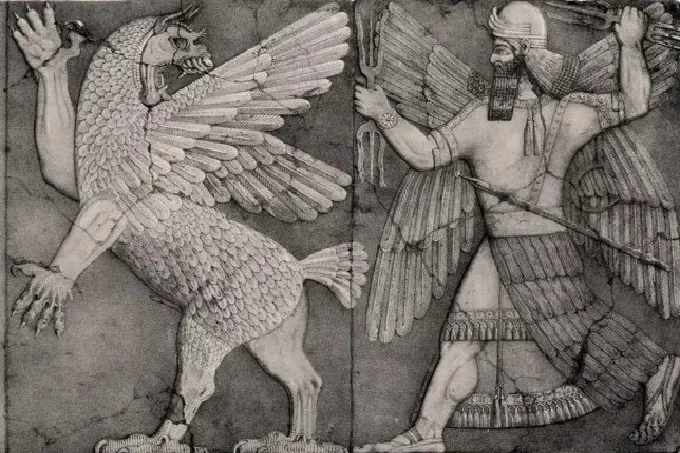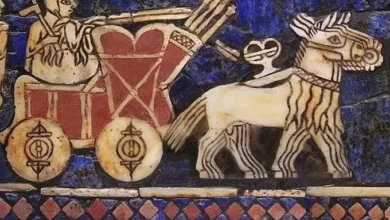Gilgamesh: how rulers enter into legends

Every person who has left a significant mark in the history of their people is idealized over time and endowed with some noble traits, often not even peculiar to them. Moreover, the more time passes from the moment of his activity, the more incredible and majestic these actions seem. Sometimes it happens that this figure is endowed with absolutely incredible, almost divine features, turning from a historical figure into a legendary one.
The first of these rulers was the Sumerian king, the founder of the First Dynasty of Uruk, Gilgamesh, who ruled in the 26th century BC. Undoubtedly, there were personalities before him whose activities were deified, for example, Narmer, who united Egypt, but it was the cult of Gilgamesh that was the first in which the exaltation of the wonderful qualities of the hero acquired a truly universal scale.
And besides, what is left of almost all the rulers of that time? A couple of artifacts and several bas-reliefs describe their exploits. The deeds of Gilgamesh are described in six cuneiform epics, each with hundreds of lines, telling in detail about everything that happened to the main character.
Some researchers believe that the “complete set” of works about Gilgamesh surpasses the Iliad and the Odyssey combined. But here, we must understand that in the works of Homer, dozens, if not hundreds of people are described, and in the books about Gilgamesh, the main character is one…
One of the most interesting facts related to these works is that they were written not after the life of the main character, but practically during it, that is, myths about the ruler were composed during his lifetime. What Gilgamesh do during his achievements, conquests, and wanderings! He captures countries, defeats giants, has affairs with goddesses, searches for the secret of immortality, saves the Earth from the flood, and much more.
Who was this man, and why did his actions find such a lively response in the hearts of the chroniclers that they had to create a whole cult of Gilgamesh’s personality?
Let’s start with the political situation of that period. Ancient Mesopotamia consisted of about four dozen independent cities located in the plains of two rivers – the Tigris and Euphrates. Cities traded and fought wars with each other. There was no question of any common state: each city was controlled by one family or clan, and the owners looked down on other cities and clans.
Every now and then, one of these forty cities intercepted the “palm” in trade, somehow forcing the main cargo flows to pass through it, but it did not come to some kind of administrative subordination of cities to each other. At the time of Gilgamesh’s appearance on the political scene, the “main” city of Mesopotamia, more precisely, its trading center, was Kish.
Gilgamesh himself was the son of a simple shepherd. More precisely, not a simple one. His father, Lugalbanda, was indeed a shepherd at the beginning of his career. However, he understood the recipe for success in time and went into the service of the priests of Kulaba. As a result, after some time, Lugalbanda himself becomes the high priest. Having removed all competitors along the religious line, he proclaims himself, no less, the “god of shepherds”, and makes his wife, Nesun, the “goddess of pastures”.
How a simple shepherd managed to do such a thing is a mystery, however, it is difficult to deny this fact, since supported by the authority of his father, Gilgamesh becomes the lugal (military leader) of the city of Uruk.
By the way, the first book about Gilgamesh, describing his actions as lugal Uruk, is devoid of any supernatural events. It describes how Gilgamesh confronts the army of Kish, who tried to force the inhabitants of Uruk to give them slaves to build a canal. The elders of the city decided to give slaves to the Chinese, however, Gilgamesh, supported by the people, refused. As a result, he defeats the army of Kish, and, returning to his city as a winner, very quickly becomes its rightful owner. Agga, the king of Kish, left without an army, gives Uruk autonomy, and Gilgamesh begins to conduct his own policy.
The result of this policy is the unification of about a dozen cities of the lower Mesopotamia into a single state with Gilgamesh at its head. Such a change in the natural course of things could not but affect the improvement of the economic situation of these cities. Before this merger, each city had its own laws, taxes, and management nuances, but after that, everything became more or less standardized and much simpler. There were practically no obstacles to crafts and trade, and they began to develop at an increased pace. In addition, freed from the need to pay tribute to someone or give away their slaves, cities began to develop faster on their own.
Which, of course, did not fail to affect the further nature of the descriptions of our hero. The second book of Gilgamesh is replete with heroic deeds and grandiose victories. It tells about his confrontation with the caretaker of a grove of giant cedars. In fact– it is just an allegorical narrative about the war of the Lower Mesopotamia and Lebanon, in which the army of Gilgamesh wins and takes rich trophies.
Every subsequent act of Gilgamesh seems more and more pretentious and majestic, until it reaches its highest point – the search for immortality and the reunion of the protagonist with the gods. As already noted, in the books about Gilgamesh, there is a place for love affairs, and for cultural and educational work. The beloved of our hero is the goddess Ishtar, and he shows his pedagogical talents in turning the beast Enkidu into a man by introducing him to the values of human civilization.
It seems that all these works were specially created to strengthen the faith of the people in their leader. And what happened in the end:
- “Gilgamesh and Agga”: Our hero is a patriot, liberating his hometown from enemies;
- “Gilgamesh and the Mountain of the Immortal”: a brilliant strategist conquering other lands;
- “Gilgamesh and the Heavenly Bull”: an ardent lover to whom nothing human is alien;
- “Gilgamesh and the Underworld”: a great educator who turns a beast into a man, a teacher who carries the reasonable, good and eternal;
- “The Death of Gilgamesh”: a brilliant scientist who learned the secret of immortality, but realizing its danger, sacrificed himself and did not apply it.
However, not all historians agree that all the works about Gilgamesh were written during his lifetime. A detailed analysis of the stylistics and vocabulary of the works makes it possible to assume that some of them were written somewhat later. In addition, the cuneiform itself changed over time – both in the style of the image of the symbols and in their content.
The dating of the first two books almost no one doubts: they were written in the 25-26 centuries BC. The time of writing the remaining books dates back to about the 18th century BC, which is almost 800 years later than the time when their main character lived. And if the authors of the first books, we can say, worked in the department of agitation and propaganda of the First Dynasty of Uruk, then who were the authors of the subsequent books, and why did they need to stir up the sands of the past almost a thousand years ago?
And everything is really simple. At that time, Mesopotamia was already called Babylon, and King Hammurabi ruled there, the same one who created one of the first sets of laws and created at that time the most perfect administrative apparatus of the Ancient World.
Hammurabi came from the Amorite Dynasty, which was formed on the ruins of the Third Ur Dynasty, and that, in turn, though remotely, took its origins from the First Dynasty of Uruk, which Gilgamesh founded. The same situation could be observed in Europe by the example of its nobility. The most seedy baronishka derived his genealogical line, if not from Clovis, then from Charlemagne with a guarantee!
So Hammurabi derived his ancestral line from the legendary Gilgamesh and, naturally, was interested in further popularizing his image. The era of Hammurabi did not require wars, it was the time of the restructuring of the old state and the creation of a new one, therefore, special attention was paid to the chronicles with a “non-military” plot.
Nothing is new in this world. Rulers will come and go, but their methods of governing the state and ways of influencing the masses will remain unchanged. However, all the same, I want to believe that the works about the exploits of Gilgamesh will remain just a beautiful fairy tale, and not the work of the ancient department of agitprop…
To get the latest stories, install our app here.




